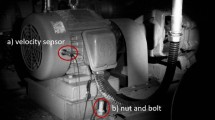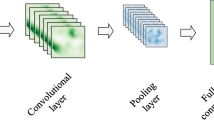Abstract
Purpose
To improve fault diagnosis efficiency, a multidimensional denoising approach based on tensor decomposition is developed for solving multidimensional signal filtering.
Methods
The monitoring signals are decomposed via truncated high-order singular value decomposition (T-HOSVD) to obtain their factor matrices. With L-curve criterion, the appropriate truncation parameters in the tensor factorization are determined to denoise and reduce dimension of signals. Then, the performance of sequentially truncated HOSVD (ST-HOSVD) is verified to quantify the correlation between the dimension of signal and computation complexity. The proposed ST-HOSVD approach is then applied to reduce noise in torque, current and vibration signals collected on bearing test rig, respectively.
Results
Experimental results show that the performance of the T-HOSVD on signals denoising are poor with the dimension increasing. The ST-HOSVD approach can well remove noise and retain the working status features as much as possible. This tensor-based multidimensional signal filtering will be powerful tool for dealing with heterogeneous and multi-aspect data.
Conclusion
The computation complexity of L-curve algorithm will increase sharply with the dimension of signal increasing while optimizing truncated parameters, but that of ST-HOSVD will not vary so much. When the dimension of the tensor model is not too high, the effectiveness of L-curve-T-HOSVD is higher. Otherwise, the computation cost of the ST-HOSVD is relatively lower. Therefore, the priority should be given to the ST-HOSVD for denoising the higher dimensional diagnostic data set about the rolling bearing.









Similar content being viewed by others
Data availability
The data that support the findings of this study are openly avaliable in "https://mb.unipaderborn.de/kat/forschung/datacenter/bearing-datacenter/".
References
Kou L, Qin Y, Zhao X, Chen X (2020) A multi-dimension end-to-end CNN model for rotating devices fault diagnosis on high-speed train Bogie. IEEE Trans Veh Technol 69(3):2513–2524
Iqbal M, Madan AK (2022) CNC machine-bearing fault detection based on convolutional neural network using vibration and acoustic signal. J Vib Eng Technol 10(5):1613–1621
Zeng C, Ng MK (2020) Decompositions of third-order tensors: HOSVD, T-SVD, and beyond. Numer Linear Algebr with Appl 27:1–15
Biswas SK, Milanfar P (2016). Linear support tensor machine : pedestrian detection in thermal infrared images. IEEE Transactions on Image Processing. pp. 1–12
Chen X, Zhang B, Gao D (2021) Bearing fault diagnosis base on multi-scale CNN and LSTM model. J Intell Manuf 32(4):971–987
Hu C, Wang Y (2019) Multidimensional denoising of rotating machine based on tensor factorization. Mech Syst Signal Process 122:273–289
Sharma V, Raghuwanshi NK, Jain AK (2021) Sensitive sub-band selection criteria for empirical wavelet transform to detect bearing fault based on vibration signals. J Vib Eng Technol 9(7):1603–1617
Liu Y, Qian Q, Liu F, Lu S, He Q, Zhao J (2017) Wayside bearing fault diagnosis based on envelope analysis paved with time-domain interpolation resampling and weighted-correlation-coefficient-guided stochastic resonance. Shock Vib 2017:1–17
Wang Z, Jia L, Qin Y (2018) Adaptive diagnosis for rotating machineries using information geometrical Kernel-ELM based on VMD-SVD. Entropy 20(1):73
Qiao Z, Pan Z (2015) SVD principle analysis and fault diagnosis for bearings based on the correlation coefficient. Measurement Science and Technology. 26:085014
Unakafov AM, Keller K (2014) Conditional entropy of ordinal patterns. Phys D Nonlinear Phenom 269:94–102
Anandkumar A, Hsu D (2014) Tensor decompositions for learning latent variable models. J Mach Learn Res 15:2773–2832
Yokota T, Lee N, Cichocki A (2017) Robust multilinear tensor rank estimation using higher order singular value decomposition and information criteria. IEEE Trans Signal Process 65(5):1196–1206
Miaoyan W, Song YS (2017). Tensor decompositions via two-mode higher-order SVD (HOSVD). The 20th International Conference on Artificial Intelligence and Statistics. PMLR 54:614–622.
Minster R, Saibaba AK, Kilmer ME (2020) Randomized algorithms for low-rank tensor decompositions in the tucker. Siam J Math Data Sci 2(1):189–215
Zhang Y, Hofmann B (2020) On the second-order asymptotical regularization of linear Ill-posed inverse problems. Apolicable Anal 99(6):1000–1025
Xiao C, Yang C, Li M (2021) Efficient alternating least squares algorithms for truncated HOSVD of higher-order tensors. J Sci Comput 87(67):1–25
Noschese S (2014) A modified truncated singular value decomposition method for discrete Ill- posed problems. Numer Linear Algebr with Appl 21(6):813–822
Kolda TG, Bader BW (2009) Tensor decompositions and applications. SIAM Rev 51(3):455–500
Mandic DP, Phan AH, Caiafa CF, Zhou G, Zhao Q, Lathauwer LD (2015) Tensor decompositions for signal processing applications. IEEE Signal Process Mag 145(March):145–163
Lu C, Feng J, Chen Y, Liu W, Lin Z (2020) Tensor robust principal component analysis with a new tensor nuclear norm. IEEE Trans Pattern Anal Mach Intell 42(4):925–938
Li Y, Xu M, Wei Y, Huang W (2016) A new rolling bearing fault diagnosis method based on multiscale permutation entropy and improved support vector machine based binary tree. Meas J Int Meas Confed 77:80–94
Vannieuwenhoven N, Vandebril RAF, Meerbergen K (2012) A new truncation strategy for the higher-order singular value decomposition. SIAM J Sci Comput 34(2):A1027–A1052
Xiao C, Yang C, Li M (2020) Efficient alternating least squares algorithms for truncated HOSVD of higher-order tensors. arXiv:2004.02583
Rezghi M, Hosseini SM (2009) A new variant of L-curve for Tikhonov regularization. J Comput Appl Math 231(2):914–924
Abdelazeem M, Gobashy M (2007) Two dimensions gravity inverse problem using adaptive pruning L-curve. Bull Fac Sci Cairo Univ 75:93–115
Liu W, Wu C (2013) A predictor – corrector iterated Tikhonov regularization for linear Ill-posed inverse problems. Appl Math Comput 221:802–818
Bernardi, A., Iannacito, M., Rocchini, D (2021) High order singular value decomposition for plant diversity estimation. Boll Unione Mat Ital 14, 557–591
Lessmeier C, Kimotho JK, Zimmer D, Sextro W (2016) Condition monitoring of bearing damage in electromechanical drive systems by using motor current signals of electric motors: a benchmark data set for data-driven classification. Third Eur Conf Progn Health Manag Soc 2016:152–156
Acknowledgements
This research is supported by the National Key R&D Program of China (NO. 2020YFB1600701).
Author information
Authors and Affiliations
Corresponding author
Ethics declarations
Conflict of Interest
The authors declare that they have no known competing financial interests or personal relationships that could have appeared to influence the work reported in this paper.
Additional information
Publisher's Note
Springer Nature remains neutral with regard to jurisdictional claims in published maps and institutional affiliations.
Rights and permissions
Springer Nature or its licensor (e.g. a society or other partner) holds exclusive rights to this article under a publishing agreement with the author(s) or other rightsholder(s); author self-archiving of the accepted manuscript version of this article is solely governed by the terms of such publishing agreement and applicable law.
About this article
Cite this article
Xu, J., Zhang, H., Sun, C. et al. Tensor-Based Denoising on Multi-dimensional Diagnostic Signals of Rolling Bearing. J. Vib. Eng. Technol. 12, 1263–1275 (2024). https://doi.org/10.1007/s42417-023-00905-9
Received:
Revised:
Accepted:
Published:
Issue Date:
DOI: https://doi.org/10.1007/s42417-023-00905-9




